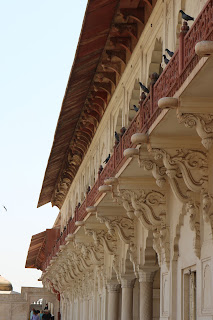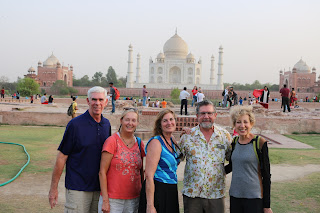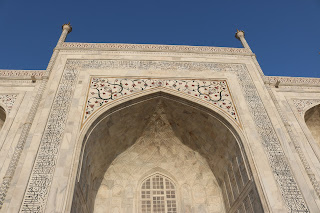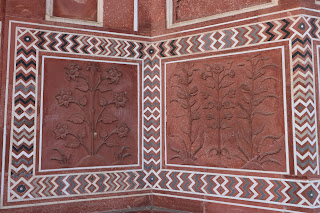March 31, 2018
After visiting the Taj Mahal, we went back to the hotel for breakfast before going to the Agra Fort. The fort was a huge complex that served as the main residence of the emperors of the Mughal Dynasty. Agra was the capital of the region until 1638 when it was moved to Delhi. The construction of the fort started in the early 1500’s and continued until the early 1600’s. The majority of the structures are made with the red sandstone.
After visiting the Taj Mahal, we went back to the hotel for breakfast before going to the Agra Fort. The fort was a huge complex that served as the main residence of the emperors of the Mughal Dynasty. Agra was the capital of the region until 1638 when it was moved to Delhi. The construction of the fort started in the early 1500’s and continued until the early 1600’s. The majority of the structures are made with the red sandstone.
This is the main entry gate.
It has some of the same style of inlaid marble designs as the Taj Mahal.
The beautifully decorated architecture.
The first courtyard has the Dewan-i-Aam (public meeting hall). It is made of the red sandstone but was painted white to look like marble.
The supports were made to slightly resemble an elephant trunk.
Behind the public courtyard you enter the private area of the Khas Mahal Palace and the Anguri Bagh gardens.
The Khas Mahal was originally built of red sandstone but was later replaced with a marble structure.
It has some of the same style of inlaid marble designs as the Taj Mahal.
A mixture of the sandstone and marble.
There are walled patio areas located on each side of the gardens. This was so parties could be held for different guests at the same time.
The beautifully decorated architecture.
In another area of the fort, a palace was built for the emperor’s son and wife.
We stopped for lunch at Sheroe’s Hangout. It stands for She+Heroes =Sheroes.
The cafe is run by a group of women who have been attacked by acid and who have fought to survive. The acid attack survivors are from various backgrounds and were attacked at different ages and for different reasons. The gentleman in the blue shirt with our group is the journalist who began writing about the attacks and the emotional and social issues surrounding the survivors. Due to his writing campaign, others rallied together and formed the cafe giving those women an opportunity to have employment and to support themselves. It was a very emotional experience talking with one lady who was attacked by her father at age 3 who was told if he killed her he could then have a boy child. He did go to prison but threatened the family that if they didn’t get him out he would have the whole family attacked. He is now living back with the family including the now 28 year old victim. The woman says she feels safe now and that she holds no grudge against her father. I don’t think I have met a more courageous person. When asked if she wanted to have any corrective surgeries she said that she was happy with her looks and she is now.
Later that afternoon we went to a marble workshop to learn how the inlaid patterns are done.
The semi-precious stones are ground to shape by hand to fit the pattern on the marble.
The pattern on the marble is slowly chiseled out by hand. All done by knowing the pattern and no stenciling is done. The marble is painted red to help the artist see his designs more clearly.
The patterns are very intricate.
Here are some pieces of stones that have been shaped and are ready to glue onto the marble. The glue used is a highly protected secret.
A piece that is setting up and then will have the red color removed.
They also work with green and black marble. The finished work is beautiful.
Tomorrow is basically a travel day as we take a 3 hour train ride then a 5 hour bus ride to reach Khajuraho.























































